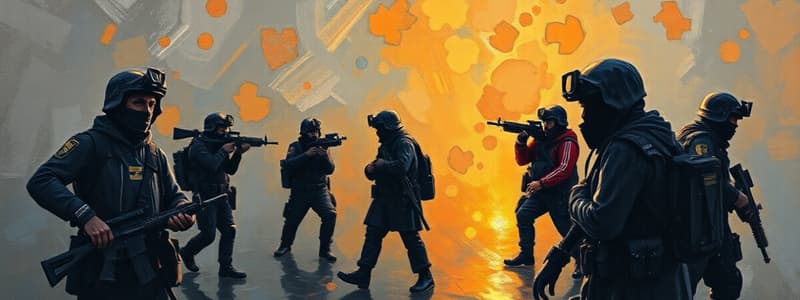Podcast
Questions and Answers
What is a significant difference between organized crime and terrorism?
What is a significant difference between organized crime and terrorism?
- Organized crime seeks indiscriminate victims while terrorism targets specific individuals.
- Organized crime avoids publicity while terrorism thrives on it. (correct)
- Terrorism focuses on economic gains while organized crime is ideologically motivated.
- Both organized crime and terrorism seek to replace government authority.
How does the global harmonization of regulation benefit crime prevention?
How does the global harmonization of regulation benefit crime prevention?
- Diminishes local law enforcement efforts and overcrowds international courts.
- Imposes stricter penalties that deter e-banking vendors from compliance.
- Increases the number of criminals by complicating the legal landscape.
- Promotes mutual legal assistance and formulation of effective action guidelines. (correct)
What is a common methodological similarity between organized crime and terrorism?
What is a common methodological similarity between organized crime and terrorism?
- Both focus primarily on political campaigning.
- Both groups conduct money laundering through the web. (correct)
- Both prefer working within government frameworks.
- Both exclusively rely on informal networks for operations.
What approach can empower local governments in responding to organized crime and terrorism?
What approach can empower local governments in responding to organized crime and terrorism?
In what way do terrorist organizations typically differ from organized crime groups regarding their objectives?
In what way do terrorist organizations typically differ from organized crime groups regarding their objectives?
Which characteristic is NOT typically associated with acts of terrorism?
Which characteristic is NOT typically associated with acts of terrorism?
What distinguishes political-social terrorism from other forms of terrorism?
What distinguishes political-social terrorism from other forms of terrorism?
Which form of terrorism is described as being ideologically focused on conservation and animal rights?
Which form of terrorism is described as being ideologically focused on conservation and animal rights?
What is a key difference between individual terrorism and group terrorism?
What is a key difference between individual terrorism and group terrorism?
Which of the following best describes state-sponsored terrorism?
Which of the following best describes state-sponsored terrorism?
What motivates individuals involved in religious terrorism?
What motivates individuals involved in religious terrorism?
What is a primary aim of terrorist acts according to the definitions provided?
What is a primary aim of terrorist acts according to the definitions provided?
What is the primary objective of cyberterrorism?
What is the primary objective of cyberterrorism?
Which type of cyberterrorism involves sophisticated coordinated attacks?
Which type of cyberterrorism involves sophisticated coordinated attacks?
What is a common method used in terror online activity for secure communication?
What is a common method used in terror online activity for secure communication?
Which of the following is NOT a characteristic of organized crime?
Which of the following is NOT a characteristic of organized crime?
What differentiates cyber gangs from traditional organized crime?
What differentiates cyber gangs from traditional organized crime?
What type of training method is increasingly used by terror organizations online?
What type of training method is increasingly used by terror organizations online?
How do organized crime groups often utilize technological advancements?
How do organized crime groups often utilize technological advancements?
What role does propaganda play in terror online activity?
What role does propaganda play in terror online activity?
What is a common use of 'electronic dead drops' in cybercriminal activities?
What is a common use of 'electronic dead drops' in cybercriminal activities?
What is a critical process involved in terror online activity related to planning?
What is a critical process involved in terror online activity related to planning?
Terrorist groups typically seek publicity while organized crime prefers to avoid it.
Terrorist groups typically seek publicity while organized crime prefers to avoid it.
The primary focus of organized crime is political change.
The primary focus of organized crime is political change.
Both organized crime and terrorist groups utilize the internet for communication and money laundering.
Both organized crime and terrorist groups utilize the internet for communication and money laundering.
Terrorist groups generally limit their victim selection to outsiders, unlike organized crime groups.
Terrorist groups generally limit their victim selection to outsiders, unlike organized crime groups.
The presence of minimal government control enhances the activities of organized crime and terrorism.
The presence of minimal government control enhances the activities of organized crime and terrorism.
Terrorism is solely defined as an act of violence without any political motives.
Terrorism is solely defined as an act of violence without any political motives.
Environmental terrorism is focused on promoting the conservation of natural resources and animal rights.
Environmental terrorism is focused on promoting the conservation of natural resources and animal rights.
State-sponsored terrorism refers to acts of terror carried out by individuals against a government.
State-sponsored terrorism refers to acts of terror carried out by individuals against a government.
The immediate victims of terrorism are always the main targets of violence.
The immediate victims of terrorism are always the main targets of violence.
Religious terrorism is viewed as less dangerous compared to other forms of terrorism due to its basis in ideology.
Religious terrorism is viewed as less dangerous compared to other forms of terrorism due to its basis in ideology.
Nationalist terrorism involves individuals with a collective perception of oppression and social commonality.
Nationalist terrorism involves individuals with a collective perception of oppression and social commonality.
Terrorism is characterized by unpredictability and the intent to instill fear in the audience.
Terrorism is characterized by unpredictability and the intent to instill fear in the audience.
Cyberterrorism primarily relies on physical destruction of infrastructure to achieve its goals.
Cyberterrorism primarily relies on physical destruction of infrastructure to achieve its goals.
Complex-Coordinated cyberterrorism involves sophisticated hacking tools and thorough target analysis.
Complex-Coordinated cyberterrorism involves sophisticated hacking tools and thorough target analysis.
Terror online activity does not include recruiting individuals for terrorist acts.
Terror online activity does not include recruiting individuals for terrorist acts.
Organized crime groups typically rely on violent methods and corruption to maintain their operations.
Organized crime groups typically rely on violent methods and corruption to maintain their operations.
Cybercriminal organizations operate primarily through physical meetings and interactions.
Cybercriminal organizations operate primarily through physical meetings and interactions.
Advanced-Structured cyberterrorism indicates a level of sophistication beyond simple hacks.
Advanced-Structured cyberterrorism indicates a level of sophistication beyond simple hacks.
Individuals engaging in organized crime often have exclusive membership and follow strict regulations.
Individuals engaging in organized crime often have exclusive membership and follow strict regulations.
Stuxnet is an example of a cyberattack that was executed quickly.
Stuxnet is an example of a cyberattack that was executed quickly.
The primary goal of cyber gangs is to engage in traditional illicit activities such as drug trafficking.
The primary goal of cyber gangs is to engage in traditional illicit activities such as drug trafficking.
Electronic dead drops are a method used for secure communication in terror online activities.
Electronic dead drops are a method used for secure communication in terror online activities.
Flashcards
Terrorism (definition)
Terrorism (definition)
Acts of violence, targeting innocents, often with methodical planning, for political or other motivations, aimed at instilling fear and communicating a message.
Motivational Classification of Terrorism
Motivational Classification of Terrorism
Classifying acts of terrorism based on the goals and motivations of the perpetrators.
Political-Social Terrorism
Political-Social Terrorism
Terrorism motivated by a desire to overthrow a government.
Nationalist Terrorism
Nationalist Terrorism
Signup and view all the flashcards
State-Sponsored Terrorism
State-Sponsored Terrorism
Signup and view all the flashcards
Religious Terrorism
Religious Terrorism
Signup and view all the flashcards
Individual Terrorism
Individual Terrorism
Signup and view all the flashcards
Organized Crime vs. Terrorism
Organized Crime vs. Terrorism
Signup and view all the flashcards
Organized Crime Tactics
Organized Crime Tactics
Signup and view all the flashcards
Terrorist Group Goals
Terrorist Group Goals
Signup and view all the flashcards
Organized Crime vs. Terrorism: Public Perception
Organized Crime vs. Terrorism: Public Perception
Signup and view all the flashcards
Organized Crime and Terrorism: Common Ground
Organized Crime and Terrorism: Common Ground
Signup and view all the flashcards
Cyberterrorism
Cyberterrorism
Signup and view all the flashcards
Cyberterrorism Types
Cyberterrorism Types
Signup and view all the flashcards
Simple-Unstructured Cyberterrorism
Simple-Unstructured Cyberterrorism
Signup and view all the flashcards
Advanced-Structured Cyberterrorism
Advanced-Structured Cyberterrorism
Signup and view all the flashcards
Complex-Coordinated Cyberterrorism
Complex-Coordinated Cyberterrorism
Signup and view all the flashcards
Organized Crime
Organized Crime
Signup and view all the flashcards
Cybergangs/Cyber Criminal Organizations
Cybergangs/Cyber Criminal Organizations
Signup and view all the flashcards
Organized Crime vs Cybergangs
Organized Crime vs Cybergangs
Signup and view all the flashcards
Terrorist Online Activity
Terrorist Online Activity
Signup and view all the flashcards
Terrorist Online Training
Terrorist Online Training
Signup and view all the flashcards
Terrorism: Key Feature
Terrorism: Key Feature
Signup and view all the flashcards
Terrorism: Motivational Classification
Terrorism: Motivational Classification
Signup and view all the flashcards
Terrorism vs. Organized Crime: Focus
Terrorism vs. Organized Crime: Focus
Signup and view all the flashcards
Terrorism vs. Organized Crime: Publicity
Terrorism vs. Organized Crime: Publicity
Signup and view all the flashcards
Terrorism and Organized Crime: Convergence
Terrorism and Organized Crime: Convergence
Signup and view all the flashcards
Terrorism & Organized Crime: Shared Conditions
Terrorism & Organized Crime: Shared Conditions
Signup and view all the flashcards
Global Harmonization: Benefits
Global Harmonization: Benefits
Signup and view all the flashcards
What is cyberterrorism?
What is cyberterrorism?
Signup and view all the flashcards
Types of Cyberterrorism
Types of Cyberterrorism
Signup and view all the flashcards
What is organized crime?
What is organized crime?
Signup and view all the flashcards
How does organized crime use technology?
How does organized crime use technology?
Signup and view all the flashcards
What are cybergangs?
What are cybergangs?
Signup and view all the flashcards
Difference between organized crime and cybergangs?
Difference between organized crime and cybergangs?
Signup and view all the flashcards
How does online training help terrorists?
How does online training help terrorists?
Signup and view all the flashcards
Why is online communication important for terrorists?
Why is online communication important for terrorists?
Signup and view all the flashcards
Terrorism vs. Cyberterrorism
Terrorism vs. Cyberterrorism
Signup and view all the flashcards
Study Notes
Defining Terrorism
- Terrorism, from a government perspective, is all criminal acts against a state or organization intending to instill terror in individuals or the public. (League of Nations Convention, 1937).
- From an academic view, terrorism is used for idiosyncratic, criminal, or political reasons.
- Unlike assassination, the direct violence targets are not the primary goals.
- Victims are often randomly or selectively chosen to spread a message through orchestrated violence.
Terrorism Characteristics
- Terrorism involves acts of violence against innocents.
- It often features methodical or serial operations with advance planning.
- It lacks moral restraints and aims to gain attention through unpredictability and fear-mongering for an audience.
- Often involves political demands.
Terrorism Classification by Motivation
- Individual Terrorism: Often overlooked due to lower impact, excluding group involvement.
- Political-Social Terrorism: Motivated by overturning a government, successful groups often labelled as patriots or freedom fighters.
- Nationalist Terrorism: Driven by a shared social identity and perceived oppression, often leading to large memberships and enduring groups from persecution.
- Environmental Terrorism (Ecoterrorism): Driven by an ideology centered on conservation and animal rights. Examples include the ELF and ALF.
- State-Sponsored Terrorism: Governments perpetrating acts against citizens or supporting acts against other governments, highlighting examples like Nazi Germany and North Korea.
- Religious Terrorism: Considered the most dangerous and persistent type due to religious extremism, appearing across various religions.
Cyberterrorism
- Cyberterrorism is using the internet for terrorist acts, including large-scale computer network disruption through tools like viruses.
- A controversial concept.
- Aims to cause alarm and panic through disruption.
- Employs computers, networks for destruction and harm for political or ideological objectives.
Cyberterrorism as a Concept
- Unlike physical terrorism, cyberterrorism focuses more on communication.
- It features a transmitter (terrorist), recipient (audience), communication channel (victims), message, and desired reaction.
Cyberterrorism Types
- Simple-Unstructured: Basic hacks using pre-made tools, with minimal target analysis, command, and control.
- Advanced-Structured: More sophisticated attacks on multiple systems, potentially modifying or creating tools, with elementary target analysis, command, and control.
- Complex-Coordinated: Coordinated attacks causing mass disruption against varied defenses, creating complex tools, strong target analysis, command and control, and organization learning.
Terror Online Activity
- Propaganda, information dissemination: Terror groups use the internet to spread their ideology.
- Recruiting & Fundraising: Online tools help recruit new members and gather funding.
- Justification for Acts: Groups might claim victimhood or lack other avenues, presenting a peaceful rhetoric to achieve goals.
- Training: Utilizing readily available online resources (legitimate & illicit) for practical training, like bomb-making.
- Research & Planning: Gathering crucial information (e.g. blueprints, manuals) and planning attacks using online resources.
- Communication: Decentralized, cheaper, and harder to detect.
- Attack Mechanism: Attacks can be swift or slow, targeting critical infrastructure like centrifuges.
Terrorism and Crime
- Criminal Activities: Identity theft, copyright infringement, cyber warfare, as well as spreading computer viruses.
- Traditional Cyber Crimes: Identity theft, virus distribution, copyright infringement, are still cyber-crimes associated with both physical and cyber-crimes.
Organized Crime
- Organized Crime: Transnational, national, or local groups engaging in illegal activities, largely for profit.
- Examples: Trafficking in nuclear materials, human smuggling, identity theft.
- Origins: Criminal gangs.
- Growing reliance on technology for more profitable crimes.
- Characteristics: Hierarchical structure, violence, recognizability, longevity, exclusive membership.
- Activities: Extortion, bank fraud, ATM fraud, money laundering, human smuggling, confidence scams, and property theft.
Cybercrime/Organized Crime Groups
- Cyber gangs: Groups formed online employing networked systems for non-violent or violent criminal acts.
- Differences (Organized Crime vs Cybergangs): Organized crime tends towards violence and physical manipulation, while cyber gangs focus on digital tools and often lack physical structure.
Confronting Contemporary Organized Crime
- Diversity amongst groups: More involvement in these organizations.
- Economic motivations: Hacking and cyberattacks are driven by economic incentives.
- Implementing financial controls: KYC (Know Your Customer) policies in banking reduce fraud.
- "Know Your Customer" (KYC) policies in financial institutions.
- Innovative hacking methods: Traditional hacking methods are growing in sophistication.
- Convergence: Transnational organized crime and terrorism are merging.
- Global cooperation: International cooperation through treaties is crucial.
- Local empowerment: Resource allocation for local responses.
- Education & accountability: Addressing educational needs and accountability for online platforms.
Intersection of Organized Crime and Terrorism
- Differences: Organized crime is economically driven, while terrorism is ideologically motivated. Organized crime aims to corrupt, and terrorism to replace, existing governments.
- Similarities: Sophistication, similar methodologies, use of the internet, often thrive in regions with minimal government controls and law enforcement.
Studying That Suits You
Use AI to generate personalized quizzes and flashcards to suit your learning preferences.




